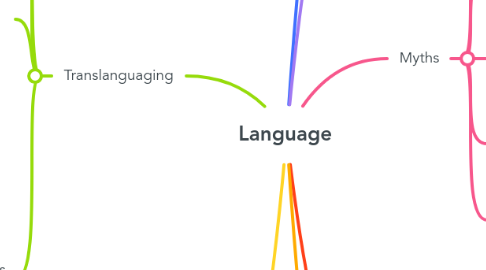
1. Translanguaging
1.1. Using all languages to communicate
1.1.1. Not switching between them
1.1.2. Building linguistic repertoire
1.1.3. A "mash up" of language
1.2. Draw on all linguistic resources
1.2.1. Relate to more content
1.2.1.1. Students have appropriate representation
1.2.1.1.1. Continued development of heritage language
1.3. Teachers accept answers in different languages
1.3.1. Have content in multiple languages
1.3.1.1. Viewing languages as assets
1.3.1.1.1. Engage with the content in multiple languages
1.4. Sense making in the PROCESS
1.4.1. If this is solid, then their products will be better.
1.4.2. Have translanguaging occur more in the process versus the product.
1.5. Is more about what the students do, not what you do.
1.5.1. How do you make translanguaging possible/available in your classroom?
1.5.1.1. Provide finished examples that include translanguaging
1.5.1.2. Ask them about aspects of their language/culture
1.5.1.3. Culturally relevant pedagogy
1.5.1.4. One-on-one encouragement
1.5.1.5. Make goals of assignment clear
1.5.1.6. Have materials in multiple languages
1.5.1.7. Give key vocabulary in multiple languages
2. Many emergent multilingual students are not encouraged to participate in STEM classes.
2.1. Relationships are at the center of collaboration but take time to establish and considerable effort to sustain.
2.1.1. Interorganizational collaboration can be sustainable over time even if the roles of the two organizations are not identical.
2.1.1.1. Robust interorganizational collaboration requires a range of supporting structures
2.1.1.1.1. Collaboration across the disciplines calls for the long-term involvement by experts from different fields and distributed leadership
3. Emergent Multilinguals
3.1. Supporting these students in turn supports other students as well.
3.1.1. Allow students to use language/dialect they are comfortable with
3.1.1.1. Find resources for emergent multilingual students
4. WIDA
4.1. Narrate
4.1.1. Share ideas
4.1.1.1. Connect stories
4.1.1.1.1. Raise questions
4.2. Inform
4.2.1. Define facts
4.2.1.1. Report patterns
4.2.1.1.1. Describe parts of systems
4.3. Explain
4.3.1. Generate initial thinking
4.3.1.1. Describe cycles
4.3.1.1.1. Compare variables
4.4. Argue
4.4.1. Generate questions
4.4.1.1. Support or challenge opinions
4.4.1.1.1. Clarify ideas
5. Myths
5.1. Children learn new languages quickly and easily
5.1.1. Find out how comfortable students are in new languages
5.2. The younger the child, the more skilled in acquiring a 2nd language
5.2.1. Don't expect too much from language learners, but expect enough
5.3. The more time they spend in a 2nd language context, the quicker they learn
5.3.1. Give support in home language whenever possible
5.4. Children have acquired a 2nd language once they can speak it
5.4.1. Be cautious in exiting a child from programs that support their home language
5.5. All children learn a 2nd language the same way
5.5.1. Be aware of cultural and individual learning styles
6. Group work
6.1. Emergent multilingual students can benefit from group work in a variety of ways...
6.1.1. Hear a variety of perspectives
6.1.2. Concepts are discussed in more appropriate language
6.1.2.1. Easier to understand
6.1.2.1.1. Multiple explanations
6.1.3. More opportunity is given to communicate in low risk ways
6.1.3.1. Listening and speaking
6.1.4. More immediate feedback is given
6.1.4.1. Can be given by peers or by teacher
6.1.5. Facilitate language learning
6.1.6. Supports students
6.1.6.1. Helps them develop new skills
6.1.6.1.1. Allows them to form social connections
